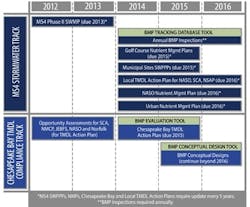Tool Development Facilitates MS4 Permit Compliance
Numerous permittees in the Chesapeake Bay watershed, which includes portions of six states (New York, Pennsylvania, Virginia, West Virginia, Maryland and Delaware) and the District of Columbia, must comply with small municipal separate storm sewer system (MS4) requirements to reduce pollutant loadings and meet Chesapeake Bay Total Maximum Daily Load (TMDL) requirements.
Despite implementing a phased approach for three permit cycles in Virginia, meeting certain pollutant reduction goals requires a significant number of resources.
Because of these aggressive pollutant reduction requirements, permittees across Chesapeake Bay are seeking cost-effective solutions to address these requirements through the year 2028. Naval Facilities Engineering Command (NAVFAC) Mid-Atlantic is responsible for compliance with Virginia’s General Permit for Discharges of Storm Water from MS4s issued to the Commander of Navy Region Mid-Atlantic.
Eight naval installations and annexes in the Hampton Roads area are covered under a regional MS4 permit. Because the MS4 permit requires tracking the inspections and maintenance of more than 300 existing storm water BMPs, Michael Baker Intl. developed a user-friendly database tool capable of sorting and creating reports using queries such as year of construction, BMP inspection type and inspection due date. Because the Chesapeake Bay TMDL Action Plan determined that approximately 200 additional BMPs are required to meet the pollutant load requirements in the pending 2018 MS4 permit, a BMP pollutant load reduction evaluation tool was developed to assist NAVFAC Mid-Atlantic with BMP decision-making. Finally, a tool was created to facilitate development of conceptual BMP designs.


